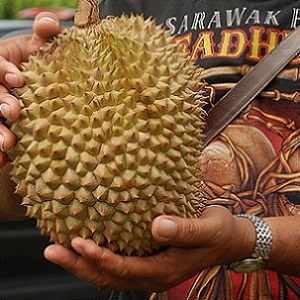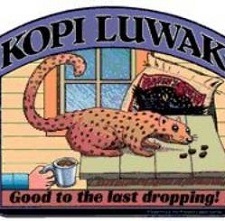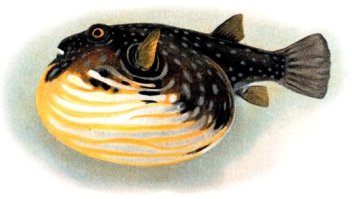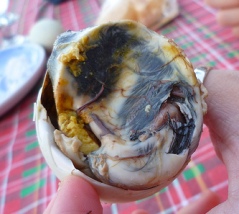
The delicious, disgusting durian fruit. Photo: Olivia Rose-Innes
We enjoyed our last serving of the world's great gross-out foods so much we thought everyone needed a second helping...
Consider these delectables: stinking fruit, faecal coffee, poisonous fish, duck foetuses and ant larvae.
Durian
The durian is known as "king of fruits" for its large size, luscious, custardy flesh – and unspeakably foul stench. In fact, in parts of southeast Asia such as Singapore, the stinking fruit is forbidden in hotels and on public transport.
Writer Anthony Burgess compared sampling durian to "eating sweet raspberry blancmange in the lavatory."
Richard Sterling describes the odour as “pig-sh*t, turpentine and onions, garnished with a gym sock.”
Still, if you can hold your nose long enough to take a bite and risk hellish “durian breath”, the taste is heavenly, apparently.
The main durian-related health risk is if it falls on your head: the fruit may weigh several kilograms, and is covered in spikes that can draw blood.
Kopi luwak
Kopi luwak is the world's most expensive coffee, admired by connoisseurs for its strong, smooth flavour notably lacking in bitterness.
All very chic until you learn it’s made from...
...cat poo.
When civet cats eat coffee beans, these absorb stomach enzymes, producing a distinctive flavour.
The cats' faeces, which contain intact beans, are washed, dried, roasted, ground and sold for vast amounts to urban sophisticates.

The sought-after coffee originated in the 18th century, when Dutch coffee-planters in Java and Sumatra banned workers from picking coffee for themselves – so locals started gathering the bean-laden civet droppings instead.
Kopi luwak is now also produced in Bali, the Philippines and Vietnam.
Surprisingly, drinking it isn't a health risk: the careful washing and roasting of the beans destroys any cat-gut bacteria.
Fugu
Fugu, or pufferfish, is a famous, perilous Japanese delicacy.
The thrill? Fugu contains tetrodoxin, a powerful poison that disrupts electrical signals in nerve cells. Only highly trained chefs may legally handle fugu: if the fish isn't meticulously prepared, it can kill.

First, your lips and tongue start to feel numb. With an especially potent serving, dizziness, exhaustion, headache, nausea, paralysis and asphyxiation follow. Although paralysed, you’ll remain conscious to the end.
There is no known antidote: treatment is stomach-pumping, activated charcoal and life support.
Every year there are dozens of fugu hospitalisations in Japan, and a few deaths. It’s the only food the Japanese Emperor is forbidden to taste.
These lines by 18th-century poet Yosa Buson evoke the fatal fugu’s perverse romantic appeal:
I cannot see her tonight
I have to give her up
So I will eat fugu.
Balut
This popular snack, sold by street vendors in Laos, Thailand, Cambodia, Vietnam and the Phllippines, looks like an ordinary boiled egg – until you crack it open.

Balut is a duck egg that has been incubated for 17-21 days,and contains a boiled-alive duck foetus, complete with beak, feathers, bones and attached yolk.
Enthusiasts love the bones' crunchy texture, and often enjoy balut with beer.
While westerners may recoil, people in south-east Asia commonly consider balut a healthy, high-protein snack that improves vigour and resistance to disease. They also believe it has aphrodisiac qualities.
Escamoles
Escamoles, or “Mexican caviar”, have a creamy texture and buttery, nutty taste. They are eaten fried in butter, or served in a taco or quesadilla with guacamole.

The catch: the soft, rice-like morsels on your plate are in fact ant larvae. These are collected from nests in the roots of the agave or maguey plant just before metamorphosing into ants.
Escamoles are healthy: insects are very high in protein, minerals and vitamins, and were an important part of the traditional Mexican diet.
The ants themselves might hurt you though: they defend their nests fiercely, forcing escamole harvesters to wear protective clothing.
What's the weirdest/grossest food you've encountered? Previous tasty offerings from readers: Nigerian swamp rat; “Walkie-talkie” (sheep's head cooked whole); “big fat squishy” Mopani worms; Italian horse meat; kudu testicles, frogs' legs, kangaroo tail, crocodile, jellyfish in peanut sauce. The author's own run-in with a slimy sea cucumber (animal, not vegetable), not to mention poor little roast Peruvian guineapigs, helped her on the path to vegetarianism.
Read more:
6 bizarre foods
References:
Onishi, N. (2010) From Dung to Coffee Brew with No Aftertaste. NewYork Times
Davidson, Alan (2006). The Oxford Companion to Food. Oxford University Press
Hosking, Richard (1997). A Dictionary of Japanese Food: Ingredients & Culture
Wallace, Alfred Russel (1856). On the Bamboo and Durian of Borneo
Rueda, Marisol (2007). Dinner with Moctezuma: have stomach, will travel through Mexico's exotic kitchens. Latin Trade, Findarticles.com
Photo credits: Durian notice by Steve Bennett; Balut by Jerick Parrone; Escamoles by Kent Wang.
Consider these delectables: stinking fruit, faecal coffee, poisonous fish, duck foetuses and ant larvae.
Durian
The durian is known as "king of fruits" for its large size, luscious, custardy flesh – and unspeakably foul stench. In fact, in parts of southeast Asia such as Singapore, the stinking fruit is forbidden in hotels and on public transport.
Writer Anthony Burgess compared sampling durian to "eating sweet raspberry blancmange in the lavatory."
Richard Sterling describes the odour as “pig-sh*t, turpentine and onions, garnished with a gym sock.”
Still, if you can hold your nose long enough to take a bite and risk hellish “durian breath”, the taste is heavenly, apparently.
The main durian-related health risk is if it falls on your head: the fruit may weigh several kilograms, and is covered in spikes that can draw blood.
Kopi luwak
Kopi luwak is the world's most expensive coffee, admired by connoisseurs for its strong, smooth flavour notably lacking in bitterness.
All very chic until you learn it’s made from...
...cat poo.
When civet cats eat coffee beans, these absorb stomach enzymes, producing a distinctive flavour.
The cats' faeces, which contain intact beans, are washed, dried, roasted, ground and sold for vast amounts to urban sophisticates.

The sought-after coffee originated in the 18th century, when Dutch coffee-planters in Java and Sumatra banned workers from picking coffee for themselves – so locals started gathering the bean-laden civet droppings instead.
Kopi luwak is now also produced in Bali, the Philippines and Vietnam.
Surprisingly, drinking it isn't a health risk: the careful washing and roasting of the beans destroys any cat-gut bacteria.
Fugu
Fugu, or pufferfish, is a famous, perilous Japanese delicacy.
The thrill? Fugu contains tetrodoxin, a powerful poison that disrupts electrical signals in nerve cells. Only highly trained chefs may legally handle fugu: if the fish isn't meticulously prepared, it can kill.

First, your lips and tongue start to feel numb. With an especially potent serving, dizziness, exhaustion, headache, nausea, paralysis and asphyxiation follow. Although paralysed, you’ll remain conscious to the end.
There is no known antidote: treatment is stomach-pumping, activated charcoal and life support.
Every year there are dozens of fugu hospitalisations in Japan, and a few deaths. It’s the only food the Japanese Emperor is forbidden to taste.
These lines by 18th-century poet Yosa Buson evoke the fatal fugu’s perverse romantic appeal:
I cannot see her tonight
I have to give her up
So I will eat fugu.
Balut
This popular snack, sold by street vendors in Laos, Thailand, Cambodia, Vietnam and the Phllippines, looks like an ordinary boiled egg – until you crack it open.

Balut is a duck egg that has been incubated for 17-21 days,and contains a boiled-alive duck foetus, complete with beak, feathers, bones and attached yolk.
Enthusiasts love the bones' crunchy texture, and often enjoy balut with beer.
While westerners may recoil, people in south-east Asia commonly consider balut a healthy, high-protein snack that improves vigour and resistance to disease. They also believe it has aphrodisiac qualities.
Escamoles
Escamoles, or “Mexican caviar”, have a creamy texture and buttery, nutty taste. They are eaten fried in butter, or served in a taco or quesadilla with guacamole.

The catch: the soft, rice-like morsels on your plate are in fact ant larvae. These are collected from nests in the roots of the agave or maguey plant just before metamorphosing into ants.
Escamoles are healthy: insects are very high in protein, minerals and vitamins, and were an important part of the traditional Mexican diet.
The ants themselves might hurt you though: they defend their nests fiercely, forcing escamole harvesters to wear protective clothing.
What's the weirdest/grossest food you've encountered? Previous tasty offerings from readers: Nigerian swamp rat; “Walkie-talkie” (sheep's head cooked whole); “big fat squishy” Mopani worms; Italian horse meat; kudu testicles, frogs' legs, kangaroo tail, crocodile, jellyfish in peanut sauce. The author's own run-in with a slimy sea cucumber (animal, not vegetable), not to mention poor little roast Peruvian guineapigs, helped her on the path to vegetarianism.
Read more:
6 bizarre foods
References:
Onishi, N. (2010) From Dung to Coffee Brew with No Aftertaste. NewYork Times
Davidson, Alan (2006). The Oxford Companion to Food. Oxford University Press
Hosking, Richard (1997). A Dictionary of Japanese Food: Ingredients & Culture
Wallace, Alfred Russel (1856). On the Bamboo and Durian of Borneo
Rueda, Marisol (2007). Dinner with Moctezuma: have stomach, will travel through Mexico's exotic kitchens. Latin Trade, Findarticles.com
Photo credits: Durian notice by Steve Bennett; Balut by Jerick Parrone; Escamoles by Kent Wang.




 Publications
Publications
 Partners
Partners









